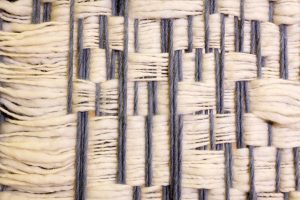Francesca Rodriguez Sawaya
In Texere, digitally generated designs make up the patterns for a hand woven textile that highlights the commonly hidden context around spoken words. Inspired by traditional Folk Art and the use of language in Oral Societies, it’s about crafting unwritten forms of language as a way of preserving the human side of collective memory.
https://itp.nyu.edu/thesis/journal2017/benedetta/author/frs256/
Description
Language shapes the way we see the world. Language is the way we learn how to communicate and relate with each other. Technology cannot capture the human side of language, and that is how things are said. And in the way we say things, is where human empathy is being shared. Digital devices transmit and store text, digits and characters, but disregard any type of context. And without it, language is being reduced to meaningless words.
This project preserves the essence of the meaning behind being human in a world that is foreseen to become more and more automated. Since technology lacks our unique capacity of transmitting empathy and we rely on computers to talk for us, this project analyzes oral histories told by people. However, preserving daily social memory must now include not only the spoken words, but the context around it, represented mainly by the patterns of intonation, pitch, volume and pauses. These are characteristics present in every language.
After performing audio analysis of oral histories collected, and gathering inspiration from traditional Folk Art and crafting techniques, a digital language pattern that translates the spoken words into weaving designs was generated. Finally, these designs became a physical weaving piece.
Classes
Thesis

